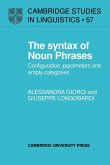One of the basic premises of the theory of syntax is that clause structures can be minimally identified as containing a verb phrase, playing the role of predicate, and a noun phrase, playing the role of subject. In this study Andrea Moro identifies a new category of copular sentences, namely inverse copular sentences, where the noun phrase which co-occurs with the verb phrase plays the role of predicate, occupying the position which is canonically reserved for subjects, and the subject is embedded in the verb phrase. The consequences of such a discovery are pervasive. Four distinct areas of syntax are unified into a unique natural class. Along with inverse copular sentences, existential sentences, sentences with seem and unaccusative constructions are analysed as involving the raising of a predicative noun phrase to the most prominent position in the clause structure. In addition, new light is shed on some classical issues such as the distribution and nature of expletives, locality theory, cliticization phenomena, possessive constructions and the cross-linguistic variations of the Definiteness Effect.








